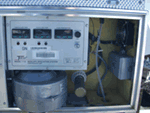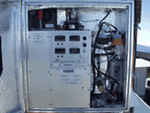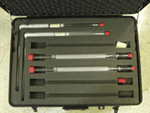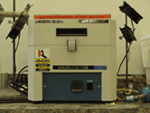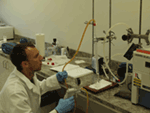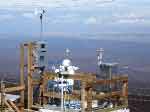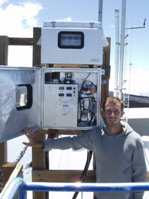More than two years after road access and electrical power to the Mauna Loa Observatory was cut off by lava flows, NOAA staff continue to make critical measurements of the atmosphere and other environmental variables at the remote site.
In 2023, observatory staff installed solar panels at the site and resumed some measurements, including the independent carbon dioxide monitoring programs run by the Global Monitoring Laboratory and Scripps Institution of Oceanography, as well as other atmospheric measurements.
Construction of a temporary road to access the observatory site is anticipated to begin in summer 2025.
Media can contact: Theo Stein (303) 819-7409 (theo.stein@noaa.gov)
Organization(s):
![]() National Oceanic and Atmospheric Administration (NOAA),
National Oceanic and Atmospheric Administration (NOAA),
Earth System Research Laboratory (ESRL) /Air Resources Laboratory (R/ARL)
What does this program measure?
- Elemental gaseous mercury (ng m-3)
- Inorganic divalent reactive gaseous mercury (pg m-3)
- Particulate phase mercury (pg m-3);
- Fine (<2.5 m m) particulate matter for trace element analysis (ng m-3)
- Coarse (2.5 - 10 m m) particulate matter for trace element analysis (ng m-3)
- Gas and particulate phase ions (primarily halides) (ng m-3).
How does this program work?
Mercury is measured via cold vapor atomic fluorescence. Particulate matter is measured with energy dispersive X-ray fluorescence & high resolution magnetic sector field inductively coupled plasma mass spectrometry. Major ions are measured via ion chromatography.
The instruments used include: Tekran Model 2537A Mercury Vapor Analyzer, Tekran Model 1130 Reactive Gaseous Mercury Sampling Unit, Tekran Model 1135 Particulate Mercury Sampling Unit, Tekran Model 2505 Primary Source Calibration Unit.
These instruments are capable of performing automated continuous or semi-continuous collection and analysis of the three forms of atmospheric mercury using the National Exposure Research Laboratories (NERL) methodology.
Why is this research important?
In order to investigate mechanisms of elemental gaseous mercury oxidation in the free troposphere and to evaluate trans-Pacific transport of mercury species. A goal is to accumulate a long-term record of ambient Elemental Mercury (Hg O), Reactive Gaseous Mercury forms (RGM), and Particulate Mercury (Hg P) chemistry to support atmospheric mercury chemistry research; to establish a baseline mercury measurement station; and to investigate the long range transport of mercury from South East Asia across the Pacific.
Are there any trends in the data?
It is too early to tell.
How does this program fit into the big picture?
What is it's role in global climate change?
Not Applicable.
Comments and References
Lead Investigator(s):
Winston Luke
301) 713-0971
MLO Contact(s):
Aidan Colton
808-933-6965 (x233)
Poai Suganuma
808-933-6965 (x232)
Web Site(s)
http://www.epa.gov/heasdweb/ecab/staff/landis.htm
http://www.epa.gov/heasdweb
Date Started
July 30, 2001
Related Programs
EPA Aethalometer
EPA Mercury Precipitation
EPA Ambient Ion Monitor
EPA Dichotomous Partisol
EPA Fine Particle Sampler
EPA Sulfur Dioxoide
EPA Surface Ozone

